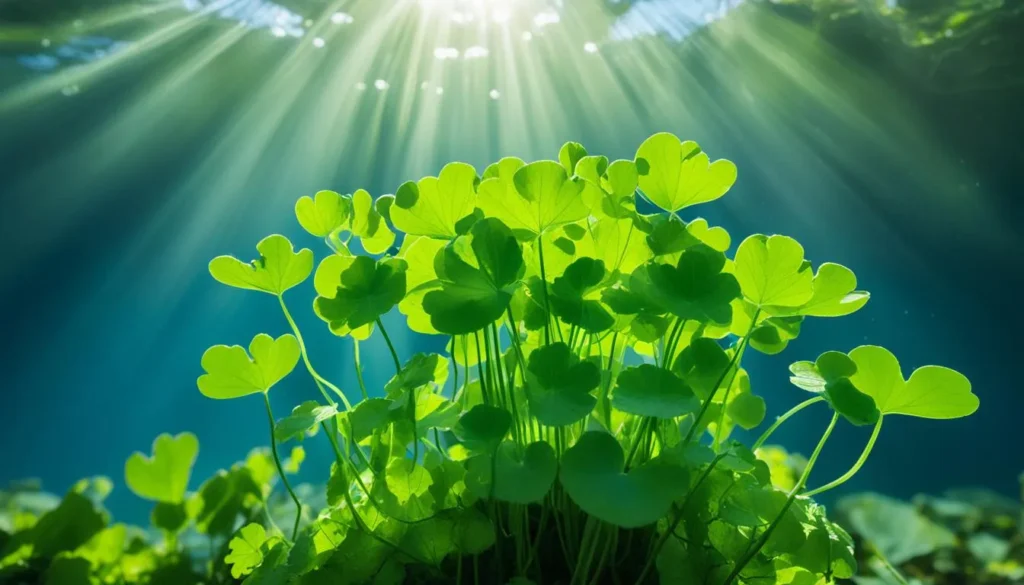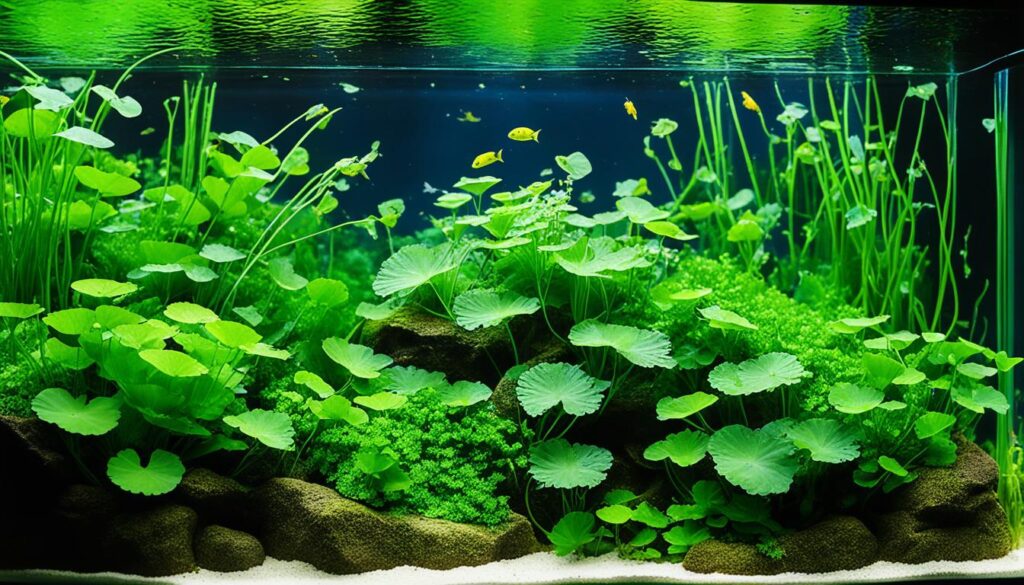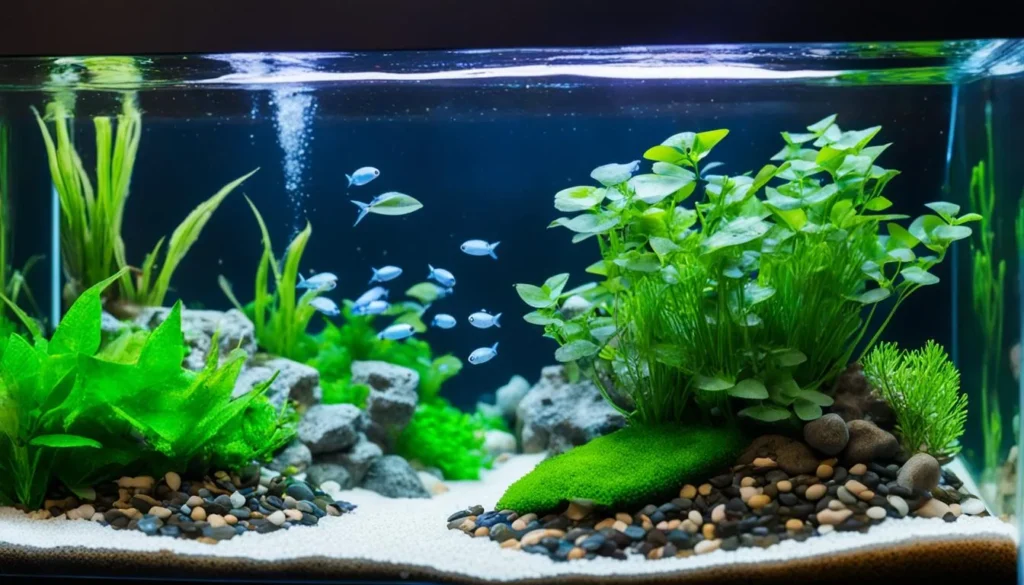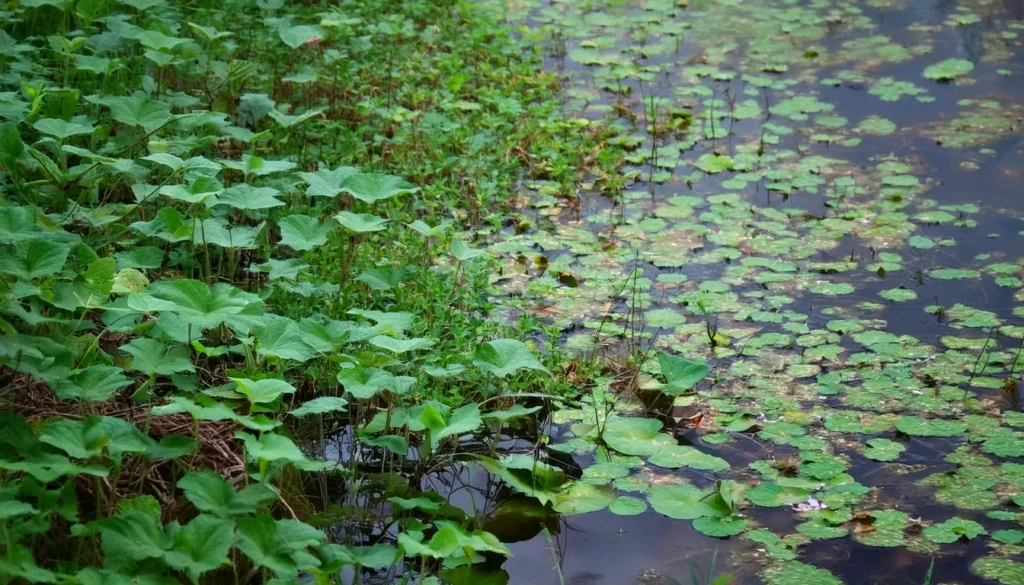Welcome to our comprehensive guide on growing lush Brazilian Pennywort in your aquarium. Brazilian Pennywort is a versatile and visually appealing plant that adds a touch of natural beauty to any aquatic environment.
In this article, we will explore the unique growth habits of Brazilian Pennywort, provide tips on creating the ideal habitat for optimal growth, and offer valuable insights on propagating and caring for this stunning plant.
Whether you’re a seasoned aquarium enthusiast or just starting, we’re here to help you achieve thriving Brazilian Pennywort in your aquarium.

Key Takeaway
- Brazilian Pennywort is a versatile and visually appealing plant for aquariums.
- Understanding the unique growth habits of Brazilian Pennywort is essential for creating an ideal habitat.
- Proper lighting, substrate selection, and water temperature are crucial for promoting healthy growth.
- Regular trimming and shaping can maintain the plant’s health and appearance.
- Brazilian Pennywort has various uses beyond aesthetics, including medicinal herb applications.
Quick Stats
| Attribute | Details |
| Family Name | Araliaceae |
| Origin | South America |
| Height | 20-60 cm (8-24 inches), can trail or climb if allowed |
| pH Range | 6.0 – 7.8 |
| CO2 Requirement | Low to Moderate |
| Growth Rate | Fast |
| Care Level | Easy |
| Color Form | Light to Bright Green |
| Water Conditions | 20-28°C (68-82°F), adaptable to a range of water hardness |
| Max Size | Can grow indefinitely in length; leaves up to 3 cm (1.2 inches) in diameter |
| Lighting | Low to High |
| Supplements | Benefits from liquid fertilizer; CO2 optional but enhances growth |
| Placement | Mid-ground to Background; can be floated |
| Propagation | Stem cuttings |
What Is Brazilian Pennywort?
Brazilian Pennywort, scientifically known as Hydrocotyle leucocephala, is a versatile plant species native to Brazil and other parts of South America.
It is commonly used as a decorative aquatic plant and can thrive both underwater and partially submerged.Brazilian Pennywort is known for its kidney-shaped leaves and unique growth habits.
It is a low-maintenance plant that can adapt to various environmental conditions, making it a popular choice for aquarium enthusiasts.

Natural Habitat And Origin
This is scientifically known as Hydrocotyle leucocephala, originates from the wetlands and marshy areas of Central and South America, including Brazil, hence its common name.
It thrives in tropical and subtropical climates, where it typically grows along the edges of streams, ponds, rivers, and other bodies of water with slow-moving or stagnant water.
Brazilian Pennywort is well-adapted to aquatic environments, where it can grow partially submerged or fully submerged in water, as well as in moist terrestrial habitats.
In its native habitat, it often forms dense mats of vegetation, providing habitat and shelter for various aquatic organisms.
Physical Characteristics
- Stem: It has long, trailing stems that can grow both horizontally along the substrate and vertically toward the water’s surface. These stems are slender and flexible, allowing the plant to adapt to various growth conditions.
- Leaves: The leaves of Brazilian Pennywort are rounded or kidney-shaped, with distinct scalloped edges. They are typically bright green in color and can vary in size, ranging from small to relatively large. The leaves grow in clusters along the stems and are arranged alternately.
- Roots: Brazilian Pennywort may develop roots at nodes along the stems when planted in substrate, although it can also grow as a floating plant without rooted stems. The roots are relatively fine and serve to anchor the plant in the substrate or absorb nutrients from the water column.
- Growth Habit: This plant exhibits a fast growth rate under favorable conditions, with stems extending rapidly and new leaves forming regularly. It has a sprawling growth habit, making it suitable for use as a background or midground plant in aquariums or ponds. Additionally, Brazilian Pennywort can grow emersed (above water) in terrestrial environments, where it may produce flowers under certain conditions.
RELATED: The Aquatic Wonder Bacopa Australis To Transform Your Aquascape
Lighting Demands For Brazilian Pennywort
- Moderate to High Light: Brazilian Pennywort can exhibit more robust growth and maintain vibrant green foliage when provided with moderate to high levels of lighting. In aquariums, this typically translates to approximately 2 to 4 watts per gallon of full-spectrum lighting or the equivalent in LED lighting.
- Low Light Tolerance: While Brazilian Pennywort prefers moderate to high light, it can also survive and grow in lower light conditions. In low-light setups, the plant may exhibit slower growth and may appear less compact, with elongated stems reaching for the light source.
- Avoiding Direct Sunlight: When grown outdoors or in ponds, Brazilian Pennywort should be protected from direct sunlight, especially during the hottest part of the day. Excessive sunlight exposure can lead to the plant’s leaves becoming bleached or scorched.
Temperature Parameters For Optimal Growth
- Tropical Climate Preference: Brazilian Pennywort originates from regions with warm, tropical climates in Central and South America. Therefore, maintaining water temperatures within the tropical range is ideal for promoting healthy growth and robust foliage.
- Avoid Extreme Temperature Fluctuations: While Brazilian Pennywort can tolerate some temperature fluctuations, it’s essential to avoid sudden or extreme changes in water temperature. Rapid fluctuations can stress the plant and may adversely affect its growth and overall health.
- Heating and Cooling: In indoor aquariums or ponds, using a reliable aquarium heater can help maintain stable water temperatures within the desired range, especially during colder seasons or in regions with fluctuating ambient temperatures. Conversely, during hot weather, providing adequate shading or using a cooling fan can prevent water temperatures from rising excessively.

Water Condition
- pH Level: Brazilian Pennywort prefers slightly acidic to neutral pH levels, ideally between 6.0 to 7.5. While it can tolerate a wider pH range, maintaining the pH within this optimal range is beneficial for the plant’s overall health and nutrient uptake.
- Water Hardness: This plant is adaptable to a wide range of water hardness levels, including soft to moderately hard water. However, it generally thrives in softer water conditions. Aim for a water hardness level of 2 to 12 dKH (degrees of carbonate hardness) or 30 to 200 ppm (parts per million) of calcium carbonate (CaCO3).
- Temperature: As previously mentioned, Brazilian Pennywort prefers water temperatures in the range of 68°F to 82°F (20°C to 28°C). Maintaining stable water temperatures within this tropical range promotes healthy growth and vigor.
- Nutrient Levels: Brazilian Pennywort benefits from adequate nutrient availability in the water column. Regularly supplementing with macro and micro nutrients, as well as using a nutrient-rich substrate or root tabs, can support robust growth and vibrant foliage. Ensure a balanced nutrient regimen to prevent deficiencies or excesses.
Substrate Requirements
- Nutrient-Rich Substrate: Brazilian Pennywort benefits from a nutrient-rich substrate that can provide essential nutrients to support its growth. Choose a substrate specifically designed for planted aquariums, such as nutrient-rich aquarium soil or aqua soil, which contains a blend of organic and inorganic compounds to promote plant growth.
- Fine Gravel or Sand: The substrate should have a fine texture to allow the plant’s roots to anchor securely and access nutrients effectively. Fine gravel or sand substrates are suitable choices, as they provide stability while allowing for proper root development.
- Depth: Provide a substrate depth of at least 2 to 3 inches (5 to 8 centimeters) to accommodate root growth and nutrient absorption. A deeper substrate layer can also help anchor the plant more securely and prevent it from floating or uprooting easily.
- Root Tabs: Consider supplementing the substrate with root tabs or fertilizer pellets specifically formulated for aquarium plants. These provide additional nutrients, including essential macro and micronutrients, directly to the root zone, promoting healthy growth and vibrant foliage.
Understanding The Unique Growth Habits Of Brazilian Pennywort
- Brazilian Pennywort is an intriguing plant that exhibits unique growth habits, making it a captivating addition to any aquarium. This versatile aquatic plant features leaves that are rounded and shaped like coins, with air-filled chambers that allow it to float gracefully in the water. The tips of the leaves have a bright white surface, creating a stunning contrast against the vibrant green foliage.
- One of the notable characteristics of Brazilian Pennywort is its fast growth rate. This plant has the ability to rapidly multiply and cover a significant area within a short period. With its vigorous growth tendencies, Brazilian Pennywort can reach up to 10 inches in height, creating a lush and vibrant underwater landscape. The stems of Brazilian Pennywort can vary in color, ranging from light green to dark green, adding visual interest to your aquarium.
- Another remarkable aspect of Brazilian Pennywort is its adaptability to different temperatures and lighting conditions. This plant can thrive in a wide range of environments, making it suitable for various types of aquarium setups. Brazilian Pennywort can adapt well and flourish in the right conditions, whether you have a freshwater or a planted aquarium.
- To create an ideal habitat for Brazilian Pennywort, it is crucial to understand its unique growth habits. By providing the appropriate temperature, lighting, and water conditions, you can ensure this fascinating aquatic plant’s optimal growth and health.

Placement And Aesthetics
When it comes to placing your Brazilian Pennywort in the vivarium, consider the following tips for optimal aesthetics:
- Choose a prominent spot in your aquarium, such as the background or center, to showcase the lush foliage of Brazilian Pennywort.
- Create a focal point by clustering multiple Brazilian Pennywort plants together and surrounding them with contrasting colors and textures.
- Position the plants in a way that allows them to flow naturally, creating a sense of movement in the water.
- Ensure that the placement of the plants does not obstruct the view of other aquatic features or fish in your tank.
Recommended Tank Size
- Nano and Small Tanks: Brazilian Pennywort can thrive in nano and small aquariums, including tanks with capacities ranging from 5 to 20 gallons. In these smaller setups, the plant can be used as a midground or background plant to add vertical interest and lush greenery to the aquascape.
- Medium-Sized Tanks: For medium-sized tanks with capacities between 20 to 50 gallons, Brazilian Pennywort can be utilized as a versatile plant for various aquascaping purposes. It can be planted along the background or sides of the aquarium to create a dense, green backdrop or used as a foreground accent plant to add depth and dimension to the layout.
- Large Tanks and Ponds: In larger tanks exceeding 50 gallons or outdoor ponds, Brazilian Pennywort can be grown on a larger scale to cover expansive areas and provide naturalistic cover for fish and other aquatic inhabitants. Its fast growth rate and ability to adapt to various conditions make it suitable for creating lush, green habitats in large aquatic environments.
RELATED: The Aquatic Wonder Bacopa Australis To Transform Your Aquascape
Companion Plants And Aquascaping Strategies
- Foreground Plants: Pair Brazilian Pennywort with smaller foreground plants, such as carpeting plants or mosses, to create depth and add texture to your aquarium.
- Midground Plants: Use taller midground plants, like Vallisneria or Anubias, to provide a contrasting backdrop for the flowing foliage of Brazilian Pennywort.
- Hardscape Elements: Incorporate rocks, driftwood, or other hardscape elements to create interesting focal points and provide a natural habitat for both Brazilian Pennywort and its companion plants.
The Nutritional Needs Of Brazilian Pennywort
- Like any plant, Brazilian Pennywort has specific nutritional needs that must be met for optimal growth. Understanding these needs is essential for maintaining the lush and vibrant foliage of your Brazilian Pennywort. Providing the right nutrients will promote healthy growth and ensure the overall well-being of the plant.
- One of the key factors in meeting the nutritional needs of Brazilian Pennywort is providing a balanced diet. This includes a mix of macronutrients, such as nitrogen (N), phosphorus (P), and potassium (K), as well as micronutrients like iron (Fe) and manganese (Mn). These nutrients can be obtained through the water column or from the substrate.
- Fertilizers can also help supplement Brazilian Pennywort’s nutritional needs. Liquid fertilizers or root tabs are commonly used to provide essential nutrients directly to the plant’s roots. It is important to choose a fertilizer specifically formulated for aquatic plants to avoid any negative effects on the aquarium’s water chemistry or other inhabitants.

| Nutrient | Function | Source |
| Nitrogen (N) | Essential for vegetative growth | Water column, fertilizers |
| Phosphorus (P) | Promotes root development and flowering | Water column, fertilizers |
| Potassium (K) | Enhances overall plant health and disease resistance | Water column, fertilizers |
| Iron (Fe) | Essential for chlorophyll production and overall plant health | Water column, substrate, fertilizers |
| Manganese (Mn) | Facilitates enzyme function and nutrient uptake | Water column, substrate, fertilizers |
When To Prune And Replant Your Pennywort?
- Knowing when to prune and replant your Brazilian Pennywort is crucial for its optimal growth. Pruning should be done when the plant becomes overcrowded or starts to outgrow its designated space. Look for signs of new growth or when the stems become too long and dense. By pruning regularly, you can maintain a well-shaped and healthy plant.
- Carefully remove a healthy stem or runner from the main plant to replant your Pennywort. To increase the chances of successful propagation, make sure clusters of leaves are intact. Once removed, plant the stem or runner into the substrate of your aquarium, allowing it to take root and establish a new plant.

Trimming And Shaping Your Pennywort
Trimming and shaping your Brazilian Pennywort is essential for maintaining its health and promoting bushy growth. Regular maintenance ensures that the plant stays neat and visually appealing in your aquarium. Here are some tips and techniques for trimming and shaping your Pennywort:
- Use clean and sharp pruning shears or scissors specifically designed for aquarium plants.
- Begin by removing any yellowing or damaged leaves. This helps redirect the plant’s energy towards healthy growth.
- Trim the stems to the desired length, keeping in mind the height and shape you want to achieve.
- To create a bushier appearance, consider cutting the stems at different heights. This encourages lateral growth and a fuller look.
- When pruning, make clean cuts just above a leaf node or where a leaf or branch originates. Avoid cutting too close to the base, as it may harm the plant.
- Regularly remove excessive growth to prevent overcrowding and maintain proper water circulation in the aquarium.

Common Pests And Diseases
- One of the common challenges Brazilian Pennywort faces is the infestation of pests and the occurrence of diseases. Pests such as snails and algae can negatively affect the growth and appearance of the plant. Additionally, diseases such as fungal infections and plant rot can also pose a threat to the health of the Pennywort plant.
- To address pests and diseases, it is crucial to regularly inspect your aquarium for any signs of infestation or infection. If you notice pests, you can manually remove them or introduce natural predators, such as certain fish species, that can help control the population.
- For diseases, maintaining good water quality and providing appropriate lighting and nutrition can help boost the plant’s immune system and prevent infections. In severe cases, treating the plant with specific medications or seeking professional advice may be necessary.
| Common Challenges | Solutions |
| Pests (e.g., snails, algae) | – Manually remove pests- Introduce natural predators- Maintain good water quality |
| Diseases (e.g., fungal infections, plant rot) | – Regularly inspect for signs of infection- Maintain good water quality- Provide appropriate lighting and nutrition |
| Water quality issues (e.g., high ammonia, nitrite, nitrate; pH imbalances) | – Regularly test water parameters- Perform regular water changes- Use water conditioners and pH-adjusting products |
Pennywort Environmental Benefits
- Brazilian Pennywort extends its influence beyond aquariums, finding applications in pond landscaping. The plant’s lush green foliage and ability to thrive in water make it an excellent choice for enhancing the natural beauty of ponds and water features.
- In addition to its captivating appearance, Brazilian Pennywort offers environmental benefits such as oxygenation, filtration, and promoting the growth of beneficial microorganisms.
- Using Brazilian Pennywort, you can create visually stunning and ecologically beneficial landscapes that contribute to your aquatic environments’ overall health and balance.The Brazilian Pennywort Care Calendar
RELATED: The AquThe Versatile Bacopa Caroliniana For Aquarists
Conclusion
It is a versatile and visually appealing plant that can enhance the beauty of your aquarium. Its unique growth habits, such as its air-filled leaves and fast growth rate, make it an interesting addition to any tank.
By creating the ideal habitat with the right water temperature, pH level, substrate, and lighting, you can ensure the lush and vibrant growth of your Brazilian Pennywort.
Propagating and caring for Brazilian Pennywort may require some knowledge and attention to detail, but the results are highly rewarding. By following proper pruning, replanting, and shaping techniques, you can maintain the desired appearance and encourage bushy growth.
Additionally, understanding the nutritional needs of Brazilian Pennywort, providing a balanced diet, and supplementing with fertilizers and CO2 can promote its overall health and vitality.
Proper design, aquascaping, and maintenance practices allow you to create a balanced and visually appealing aquarium display with Brazilian Pennywort as a focal point.
Not only does it enhance the aesthetics of your tank, but it also offers various uses beyond its beauty. From its medicinal herb uses to its benefits in pond landscaping and the environment, Brazilian Pennywort is a valuable addition to any aquatic setting.
Frequently Asked Question
What Is Brazilian Pennywort?
Brazilian Pennywort, scientifically known as Hydrocotyle leucocephala, is a versatile plant species native to Brazil and other parts of South America.
It is commonly used as a decorative aquatic plant and can thrive both underwater and partially submerged.
What Are The Unique Growth Habits Of Brazilian Pennywort?
Brazilian Pennywort features kidney-shaped leaves and air-filled stems. It has a fast growth rate and can adapt to different temperatures and lighting levels.
It can reach a height of up to 10 inches, and its stems can vary in color from light green to dark green.
How Can I Create The Ideal Habitat For Brazilian Pennywort?
To create the ideal habitat, you need to consider the plant’s water temperature and pH preferences, choose the right substrate, and provide appropriate lighting conditions for healthy foliage.
What Are Some Design Tips For Using Brazilian Pennywort In An aquarium?
For a visually appealing layout, consider vivarium placement, aesthetics, companion plants, and aquascaping strategies that complement Brazilian Pennywort.
What Are The Nutritional Needs Of Brazilian Pennywort?
Brazilian Pennywort requires a balanced diet and may benefit from fertilizer supplementation. The role of CO2 in promoting healthy growth should also be considered.
- Unveiling The Wonders Of Riccia Fluitans In Aquascapes - August 7, 2024
- Vallisneria Gigantea Var. Guide To Care And Cultivation At Home - July 31, 2024
- Vesicularia Dubyana Care & Growth Guide Tips For Beginner Gardeners - July 30, 2024
